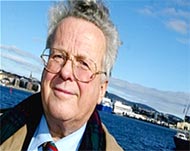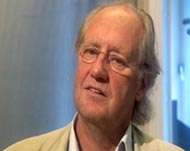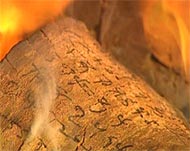Stealing history
A generation of children in remote but archeologically rich areas of Afghanistan and Pakistan is learning to loot the very heritage that defines them as a people, according to a British journalist.

Equally sad, David Hebditch says, is that a gross crime against culture takes place for the benefit of well-paid scholars, unscrupulous dealers and unprincipled antiquity collectors.
Speaking to Aljazeera.net on Thursday, Hebditch said his documentary film, Stealing History, followed just one of many illegal relic trails from start to finish.
He named Norwegian collector Martin Sch?yen as the eventual “owner” of valuable birch-bark 1500-year-old Buddhist manuscripts that were unlawfully removed from Afghanistan and Pakistan from 1993 onwards.
 |
|
Martin Sch?yen’s 13,000-piece |
The documentary also records interviews with a shepherd in Gilgit who initially uncovered one of these manuscripts for a bag of wheat; the Peshawar dealer who sold it on for $80,000; a UK-based smuggler who brought them to London; and even the Mayfair dealers who sold them on for a healthy profit to private collectors.
With just three policemen in the whole of the UK specifically employed to investigate illicit trade in antiquity dealings, Hebditch says it is easy to imagine the consequences.
“Pakistan, Afghanistan and Iraq have suffered a wave of plundering in museums and archaeological sites … the same thing that happened after the Gulf War in 1991,” he said.
Speaking from police headquarters at Scotland Yard, British detective Richard Ellis concludes that “up to two-thirds in major antiquity sales is unprovenanced … where is it coming from? Undoubtedly some of it is looted”.
Radio defence
But for collectors, the lure of owning such rare documents is too great a temptation to fret about the law.
In a broadcast on Norway’s NRK radio station in 2001, Sch?yen told listeners how he had saved thousands of pieces of a substantial Buddhist text from a Taliban attack in Bamiyan.
|
“Pakistan, Afghanistan and Iraq have suffered a wave of plundering in museums and archaeological sites … the same thing that happened after the Gulf War in 1991” |
“There were some Buddhists fleeing from the regime who took shelter in some caves where they suddenly found these inscribed fragments on birch bark and palm leaves … because a book that had been in the hand of a statue of Buddha had been blown into a thousand pieces.
Sch?yen added, “And all these pieces are now in my possession and are now being put together. I saw it as a rescue operation to save some of the world’s heritage that would otherwise have been destroyed.”
Robert Coningham, who heads the Illicit Antiquities Research Centre at Cambridge University, comments that “there is no way that the material could have reached Europe and Norway without being illegally transported and acquired”.
Worse, the fact is that the text Sch?yen “saved” was never in Bamiyan and had been smuggled out of northern Afghanistan before the Taliban even came to power.
Unesco archaeologist Kazuya Yamauchi confirmed that the fragments had come from the village of Zargaran in 1993, when a landslide unsealed a cave.
Locals who described the incident were happy to tell Yamauchi they had picked up the inscriptions they found inside and sold them on.
Scholarly defence
Understanding a collector’s ambition to break international law in an attempt to expand a multi-million-dollar collection is one thing, but for scholars to defend the practice is something else.
Jens Braarvig, who is editor-in-chief of the Sch?yen collection and describes it as “scholarly gold”, admits that he has very little knowledge concerning the origins of the artefacts.
 |
|
Braarvig, the collection’s editor, |
“I’m not a specialist on that”, the professor, who has studied the inscriptions for years, said.
“I think they have been in private collections since the ’30s … but I must underline I do not know the details”.
But the professor might have had his suspicions as far back as 1998, particularly when it became clear that some of the documents were known to have been catalogued in Afghanistan’s national museum in Kabul.
Thanks to the studies of French scholar Sylvan Levi in 1932, several of the inscriptions in the Sch?yen collection must be described as stolen property. Braarvig admits that a few artefacts “have crept into the collection”, but has made no effort to investigate further.
Saving heritage?
Some may argue that, no matter how it is acquired, it is better to have collectors and scholars who clearly love artefacts to keep them – because they preserve and study them.
When Braarvig was asked why clearly stolen property had not been returned, he replied “because that was decided to be the best”.
Is it better to have collectors create a demand for artefacts that would otherwise just stay underground and undiscovered?
 |
|
Excavated by peasants, relics |
The answer, according to Dr Coningham, must be yes. One of the smugglers interviewed on Stealing History, admitted to breaking up inscriptions because two broken ones were worth more than one whole.
“What is happening now is that collectors have become better known, so more and more material is coming out … demand is accelerating the destruction of sites,” Dr Coningham said.
“It may save the things we see, but remember that numerous artefacts will be destroyed in the search for them and in their transit … and of course the context for the artefacts is being destroyed as well.”
What should happen
Although the security conditions in Afghanistan and northern Pakistan do not allow for the mass return of stolen relics, there is a much more acceptable and legal alternative to saving cultural heritage.
Unesco spokeswoman Louise Haxthausen points out that the world body has set up a museum in Switzerland: the Afghan National Museum in Exile.
 |
|
Attracted by quick money, little |
“It is not a matter of handing it over immediately. … It is a matter of creating a clear agreement or commitment to returning the manuscripts on a particular date.” But to date this has not happened.
And even when Sch?yen publicly claimed to have written to Afghanistan’s Culture Minister Sayyid Rahin to offer to hand back just two of thousands of manuscripts in June 2004, both Dr Rahin and National Museum Director Umar Khan Masudi denied any such letter had ever been received.
Rahin said “it is a moral duty of everyone to return them back. I would encourage scholars and intellectuals to give the manuscripts back”.
Ex-middleman Michael Van Rijn, who helps British police tackle the enormous problem in illegal artefact dealing, is rather more blunt.
“I don’t feel any sympathy for people like Martin Sch?yen. I don’t care how many professors he buys and how many descriptions he makes of his looted material. It is looted.”